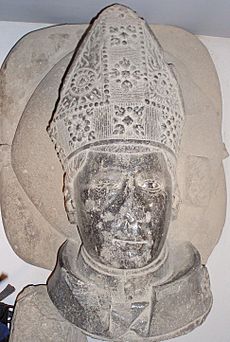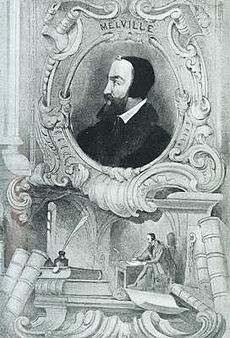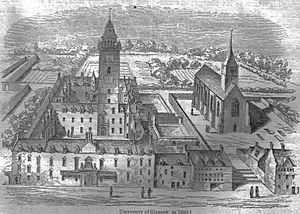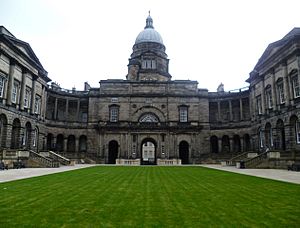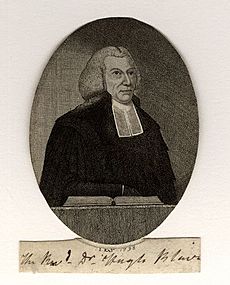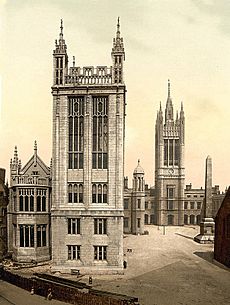History of universities in Scotland facts for kids
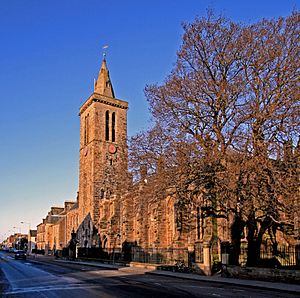
The history of universities in Scotland tells the story of how universities and colleges in Scotland grew and changed, from their beginnings in the 1400s to today. For a long time, Scots who wanted to go to university had to travel to other countries like England or Europe.
This changed when the first Scottish university, St John's College, St Andrews, was founded in 1418. More colleges were added in St Andrews, and then the University of Glasgow started in 1451. King's College, Aberdeen followed in 1495. At first, these universities mainly trained people for the church. But soon, more ordinary people started attending.
Over time, Scottish universities became very important. In the 1700s, they grew from small local schools into major places of learning. They were seen as key to Scottish identity and helped people improve their lives. Medical schools became famous, especially Edinburgh's medical school. It was easier and cheaper to attend Scottish universities than those in other countries. This helped Scotland become a big part of the Scottish Enlightenment, a time of great new ideas.
In the 1800s, universities changed again. They started adding science degrees and became more modern. Student numbers grew a lot. By the end of the century, over 6,000 students were attending. In the 1900s, there was a huge expansion. The number of universities doubled, with new ones like University of Dundee, Strathclyde, Heriot-Watt, and Stirling opening. Later, in 1992, many colleges became universities, adding places like Abertay and Glasgow Caledonian. Today, Scottish universities continue to be important centers for learning and research.
Contents
Early Universities in Scotland
Before Scottish Universities
For many years, if you lived in Scotland and wanted to go to university, you had to travel. People went to places like Oxford or Cambridge in England. They also traveled to Europe, to famous universities in Paris, Cologne, or Vienna.
One very important Scottish thinker from this time was John Duns Scotus (who lived from about 1266 to 1308). He studied in Oxford, Cambridge, and Paris. He became a major influence on religious ideas in the Middle Ages. When the Wars of Scottish Independence started, English universities became closed to Scots. So, more Scottish scholars went to universities in Europe. Some even became teachers there, like John Mair in Paris.
First Universities Appear
The first university in Scotland was founded in 1418. Bishop Henry Wardlaw of St. Andrews asked the Pope for permission to start St John's College, St Andrews. He said that Scottish students in other countries were being treated unfairly.
Soon after, St Salvator's College was added in St Andrews in 1450. Then, the University of Glasgow was founded in 1451. King's College, Aberdeen followed in 1495. These universities were often inspired by famous European universities like Paris.
At first, these new Scottish universities mainly trained people to be priests or lawyers. But more and more, ordinary people started attending. They only offered basic degrees. If students wanted more advanced studies, they still had to go abroad. This helped Scotland stay connected to the wider world of European learning.
Around this time, a new way of thinking called Humanism became popular in Europe. Humanism focused on classical writers and new subjects like Greek. Scottish universities were slower to adopt these ideas. But by the late 1400s, humanism started to appear. For example, Hector Boece, a humanist who studied in Paris, became the first head of the new university in Aberdeen in 1497. These international connections helped bring new ideas into Scotland.
Universities in the Modern Era
Changes in the 1500s
The ideas of humanism, which valued order and good behavior, began to strongly influence education. King's College Aberdeen was restarted in 1515, offering theology, law, and medicine. St Leonard's College was founded in St Andrews in 1511.
St Mary's College, St Andrews was restarted in 1538. It focused on humanist ideas and studying the Bible for future church leaders. In Edinburgh, public lectures on law, Greek, Latin, and philosophy started in the 1540s. These lectures eventually grew into the University of Edinburgh in 1582.
Scotland went through a big religious change called the Protestant Reformation in the mid-1500s. After this, Scottish universities were reformed by Andrew Melville. He had studied in Geneva and was a brilliant linguist and philosopher. Melville changed how things were taught. He introduced new teachers for different subjects, instead of one teacher covering everything. He made Greek a required subject and added other ancient languages like Aramaic and Hebrew.
Melville's changes made Scottish universities much better. They started offering an education that was as good as the best universities in Europe. Student numbers at the University of Glasgow grew a lot after he arrived. He also helped set up Marischal College in Aberdeen in 1593.
The 1600s: Growth and Challenges
King James IV (who was also James I of England) made some changes to the universities. In 1617, he said that the college in Edinburgh should be called King James's College. In 1641, the two colleges in Aberdeen were joined together by King Charles I to form the "King Charles University of Aberdeen."
During the time of the Commonwealth (1652–1660), universities received more money. This helped them complete new buildings, like the college in Glasgow. After the king returned to power in 1660, some people were removed from the universities. But many of the good changes in learning stayed. The two colleges in Aberdeen were separated again.
Scottish universities recovered from these difficult times. They started offering lectures on new subjects like economics and science. This gave a good education to the sons of noble families and wealthy landowners. New positions for mathematics teachers were created in all the universities. Observatories were built for studying astronomy. The first Professor of Medicine was appointed in Edinburgh, helping Scotland become a leader in medical education.
The 1700s: A Time of Enlightenment
In the 1700s, Scottish universities changed a lot. They went from being small local schools to major centers of new ideas. They were seen as important for democracy and for people to improve their lives. New medical teaching positions were created in Aberdeen, Glasgow, St Andrews, and Edinburgh.
Edinburgh's medical school, founded in 1732, became the most important medical center in Europe. It was a leading place for medicine around the world.
It was probably easier for people from all parts of society to attend Scottish universities than in other countries. It cost less money, and students came from more different backgrounds. The way of teaching was flexible, and the subjects became more modern, focusing on philosophy and science. Scotland gained a lot from this system, contributing greatly to the European Enlightenment. Many important thinkers of the Scottish Enlightenment were university professors who shared their ideas in lectures.
One of the first big philosophers of the Scottish Enlightenment was Francis Hutcheson (1694–1746) at the University of Glasgow. He taught that what is good is what brings "the greatest happiness for the greatest numbers." His students, like David Hume and Adam Smith, helped develop modern science and ideas about how science and religion relate.
Adam Smith's book The Wealth of Nations (1776) is considered the first book on modern economics. It had a huge impact on how countries managed their money and still influences discussions about trade today. Other Scottish thinkers explored science, like William Cullen (a doctor and chemist) and James Hutton (the first modern geologist).
The 1800s: Modernizing Universities
At the start of the 1800s, Scotland's five universities had about 3,000 students. There was no entrance exam, and students often started at 15 or 16. They might only attend for two years and leave without a degree. The main subjects were religion and law.
There was a big effort to make the universities more modern. They wanted to add degrees in science and meet the needs of the growing middle class and different professions. This led to new laws in 1858 and 1889 that changed the university system.
New entrance exams were introduced, and students started university at an older age, usually 17 or 18. Degrees became more structured, with three-year ordinary degrees and four-year honors degrees. New subjects, especially in the sciences, were added. The University of Glasgow even had the world's first engineering professorship. By the 1870s, science was well established in Scottish universities.
All universities were reorganized. They got new governing bodies called Courts, which included outside members to help manage money. Student councils were also created. New subjects like Modern History, French, German, and Political Economy were added to the arts curriculum.
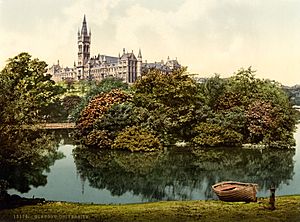
The University of St Andrews saw a revival and was the first Scottish university to allow women to study for degrees in 1882. From 1892, all Scottish universities could admit and graduate women. A new college of St Andrews opened in Dundee in 1883, which helped the university teach sciences and open a medical school.
The University of Glasgow became a leader in British higher education. It moved to grand new buildings at Gilmorehill in 1870, paid for by public donations. The two colleges in Aberdeen were combined to form the University of Aberdeen in 1860. The University of Edinburgh, which was originally a city college, was also reorganized to be similar to the older universities.
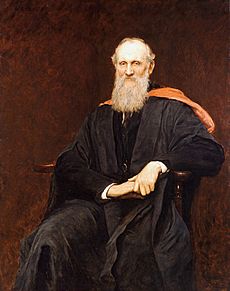
These changes made Scottish universities much stronger. Student numbers grew to over 6,000 by the end of the century. They produced many famous figures in both arts and sciences. For example, William John Macquorn Rankine made Glasgow a leading center for engineering. Thomas Thomson started one of the first chemistry laboratories in the world at Glasgow. Lord Kelvin, a brilliant scientist, also taught at Glasgow and made important discoveries in electricity and physics.
At Edinburgh, David Brewster contributed to optics and photography. In medicine, Joseph Lister and William Macewen pioneered antiseptic surgery, which made operations much safer. Scottish universities also produced important thinkers in human studies, like the anthropologist James George Frazer.
The 1900s to Today
In the early 1900s, many students received financial help to attend university. By 1913, there were almost 8,000 students, and about a quarter of them were women. However, in the first half of the 1900s, Scottish universities didn't grow as fast as those in England or Europe. Student numbers fell, partly because there were fewer jobs for women graduates.
After the 1960s, there was a huge expansion in higher education in Scotland. The number of universities doubled. The University of Dundee became separate from St Andrews. Strathclyde and Heriot-Watt grew from technical colleges. The University of Stirling was built as a brand new university in 1966.
In the 1970s and 80s, the government focused on expanding education in colleges rather than universities, as colleges were cheaper. But in 1992, a new law removed the difference between universities and colleges. This created new universities like Abertay, Glasgow Caledonian, Napier, Paisley, and Robert Gordon.
The number of female students grew much faster than male students. By 1999-2000, there were more women than men studying at Scottish universities for the first time.
After Scotland gained its own government in 1999, a big change was made: student tuition fees were abolished. Instead, students could get grants based on their financial need. In 2001, the University of the Highlands and Islands was created by joining several colleges and research centers. It became a full university in 2011.
In 2008-2009, about 231,000 students were studying at universities or higher education institutes in Scotland. More than half of them were female.


